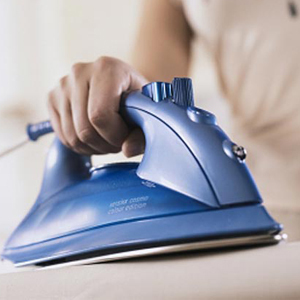
- Rule 1. Suitable handy iron
- Rule 2. Correct ironing board
- Rule 3. Observe temperature conditions for different fabrics
- Rule 4. Degree of drying of things
- Rule 5. Direction of iron and intensity of pressure
- How to iron things that can not be doneironing?
- Useful advices:
To look neat and beautiful, you need not only to erase all items of the wardrobe in time, but also be able to iron properly. For some, this procedure is akin to torture, but if you know some secrets, ironing clothes will not only not be a tedious business for you, but it may become one of your favorites. It is about how quickly to stroke various things, with minimal effort, you will learn from this article.
to the contents ↑Rule 1. Suitable handy iron
 Before you iron the laundry, look at your household tool. Maybe the whole problem of long and zealous efforts to put their things in order is just in it? Compare its characteristics with those that we give below and think about the fact that it's probably time to replace your device.
Before you iron the laundry, look at your household tool. Maybe the whole problem of long and zealous efforts to put their things in order is just in it? Compare its characteristics with those that we give below and think about the fact that it's probably time to replace your device.
Ironing the laundry will be much easier if the iron has:
- the optimal weight is specific for you - too light or heavy will help the hand to quickly get tired;
- ergonomic and comfortable grip;
- high-quality non-stick surface of the sole - an ideal ceramics;
- is a stripping function, the holes being evenly distributed over the entire working surface, rather than at a single point;
- self-cleaning function - by this you eliminate the risk of contamination of things and save your time for its regular cleaning;The
- auto-shutdown function is a very necessary and practical feature, with this iron you will not worry that you may have forgotten to turn it off.
Rule 2. Correct ironing board
To quickly iron the clothes and not get tired at the same time, one good iron will be small.
Adjust the height of the board. The distance between the elbow and the surface of the board should be 27 cm. Be sure to take into account the position in which you iron - if sitting, then put the height of the board in this position, if standing - respectively.
Important! If it is too high or low, the back will become numb, there will be pain in the wrist and the hands will excessively overextend - there may even be a keratura.
to the contents ↑Rule 3. Observe the temperature regime for different fabrics
Linen can be sorted not only by color, but also by type of fabric. Begin to iron clothes from those products that require the lowest temperature:
- 50S - nylon, kapron, some types of synthetics;
- 100С - artificial silk;
- 150С - woolen things;
- 200C - linen and cotton.
Important! To know exactly what clothes and at what temperature to iron - look at the manufacturer's specific recommendations on the label.
to the contents ↑Rule 4. Degree of drying of things
To iron the clothes qualitatively and not to spend too much time on it, it is necessary to dry the thing from the very beginning. To do this, consider the following recommendations:
- Linen and cotton products are easier to smooth if they are slightly damp.
- Silk is straightened only in a completely dry form and from the underside.
- Wool, flannel, tweed - dry, but for ironing use a damp gauze, plus the last 2 treat from the wrong side.
- Color knitwear - lightly moisten, but not just water, and a weak vinegar solution.
- Corduroy and velvet - they are only ground with steam after full drying and, preferably, in an upright position, so as not to rub the pile.
- Any material with beads, rhinestones, embroidery is smoothed only through a wet terry towel.
Rule 5. Direction of iron and intensity of pressure
 Long and hard to iron clothes do not like anyone. Yes, it does not need. Are you sure you are using the iron correctly? Review the recommendations in the list below to understand what exactly you are doing wrong:
Long and hard to iron clothes do not like anyone. Yes, it does not need. Are you sure you are using the iron correctly? Review the recommendations in the list below to understand what exactly you are doing wrong:
- Flax and knit wearers move smoothly and smoothly, the direction is up or down. Do not hurry around in circles with an iron on the material.
- Bedding sets, tablecloths and curtains - treat with light movements, from the front side, lightly moistened.
- Dresses properly ironed: seams from the inside, darts, hem, then - all the rest of the thing.
- Shirts: the gate - from the corners to the middle, first the underside, then the front surface, the sleeves - from the center to the edges, without forming an arrow.
How to iron things that can not be ironed?
If on the label you found a sign that you can not iron the laundry, use the following tips to straighten the fabric:
- Hang it over the basin with hot water so that the rising steam spreads the fibers.
- Use the vertical steaming function, after hanging clothes on the hanger.
- For a very dense fabric, the "steam stroke" function is suitable.
Tips and Tricks:
- Make sure that things and iron are clean before ironing. Any particles of dirt when heated can simply be soldered onto the fabric of the same thing or the next. Remove such spots will be very difficult.
- Do not overdry things.
- Begin to iron things with thinner and brittle ones, which need less temperature and delicate handling. The iron is heated much faster than it cools.
- Immediately after ironing, allow the fabric to cool slightly, and then add the product or hang it on the hanger.
- Always carefully hang or fold things to avoid the need to re-straighten the folds.
Now you know all the rules of how to iron clothes. Use these tips and you will easily be able to cope quickly even with a large slide of washed clothes.
